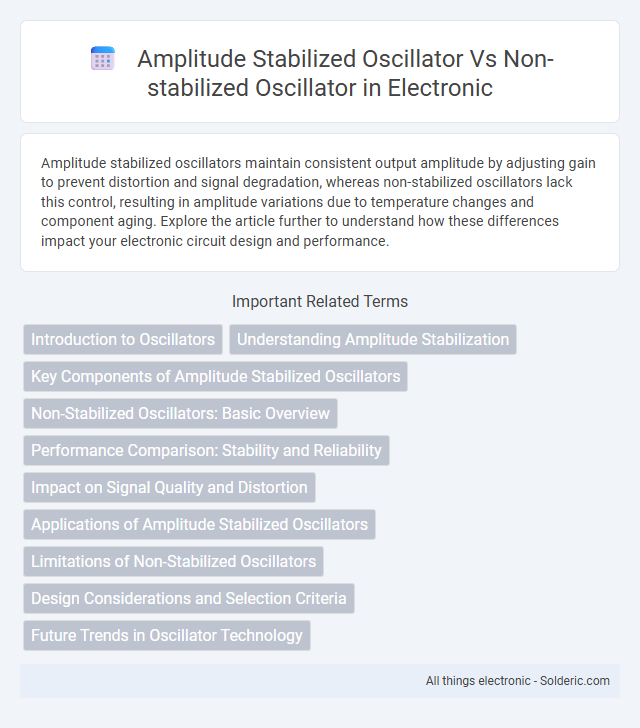Amplitude stabilized oscillators maintain consistent output amplitude by adjusting gain to prevent distortion and signal degradation, whereas non-stabilized oscillators lack this control, resulting in amplitude variations due to temperature changes and component aging. Explore the article further to understand how these differences impact your electronic circuit design and performance.
Comparison Table
| Feature | Amplitude Stabilized Oscillator | Non-Stabilized Oscillator |
|---|---|---|
| Amplitude Stability | Constant; maintains fixed amplitude | Amplitude varies; prone to distortion |
| Output Signal Quality | Low distortion, stable waveform | Higher distortion, unstable waveform |
| Frequency Stability | High frequency consistency | Frequency varies with component changes |
| Complexity | More complex design due to stabilization circuit | Simpler design, less components |
| Power Consumption | Higher due to stabilization mechanisms | Lower; no stabilization circuits |
| Applications | Precision signal generation, communication systems | Basic signal generation, low-cost applications |
| Example Circuits | Limiter-based, AGC (Automatic Gain Control) oscillators | Simple RC, LC oscillators without feedback control |
Introduction to Oscillators
Oscillators generate periodic signals essential in communication and signal processing, with amplitude stabilized oscillators maintaining consistent output amplitude through feedback control mechanisms, thereby enhancing signal stability and reducing distortion. Non-stabilized oscillators lack amplitude regulation, leading to variations in output amplitude that can result in signal degradation and less reliable performance. The choice between stabilized and non-stabilized oscillators impacts the precision and quality of frequency generation in electronic systems.
Understanding Amplitude Stabilization
Amplitude stabilized oscillators maintain consistent output signal amplitude by employing feedback mechanisms, ensuring signal integrity and reducing distortion. Non-stabilized oscillators experience amplitude variations that can lead to signal degradation and frequency instability. Understanding amplitude stabilization helps you design circuits with reliable performance in applications requiring precise and stable oscillation.
Key Components of Amplitude Stabilized Oscillators
Amplitude stabilized oscillators rely on key components such as automatic gain control (AGC) circuits, limiting amplifiers, and feedback networks to maintain a constant output amplitude despite variations in temperature or power supply. These components work together to adjust the gain dynamically, preventing signal distortion and ensuring frequency stability. Your circuit's performance benefits significantly from the inclusion of these stabilization elements compared to non-stabilized oscillators, which lack amplitude regulation and may experience amplitude drift and distortion.
Non-Stabilized Oscillators: Basic Overview
Non-stabilized oscillators generate signals without automatic amplitude regulation, leading to output variations due to environmental changes or component aging. These oscillators are simpler and cost-effective but can experience signal distortion and reduced reliability over time. For your applications requiring consistent signal strength, non-stabilized oscillators may pose challenges in maintaining stable output amplitude.
Performance Comparison: Stability and Reliability
Amplitude stabilized oscillators offer superior stability by maintaining constant output amplitude despite variations in temperature and power supply, resulting in reduced signal distortion and improved waveform quality. Non-stabilized oscillators tend to exhibit amplitude fluctuations that cause phase noise and frequency drift, compromising reliability in sensitive applications. The enhanced amplitude regulation in stabilized oscillators ensures consistent performance, making them ideal for precision electronics and communication systems requiring long-term operational stability.
Impact on Signal Quality and Distortion
Amplitude stabilized oscillators maintain consistent output amplitude, significantly reducing signal distortion and enhancing signal quality in communication and sensor systems. Non-stabilized oscillators experience amplitude variations that cause distortion, frequency drift, and increased phase noise, degrading overall signal fidelity. The stability provided by amplitude stabilization ensures reliable performance in precision applications such as RF transmitters and instrumentation.
Applications of Amplitude Stabilized Oscillators
Amplitude stabilized oscillators find crucial applications in precision signal generation, frequency synthesis, and communication systems where maintaining a constant output amplitude is essential for signal integrity. Your choice of an amplitude stabilized oscillator enhances performance in phase-locked loops, frequency modulators, and instrumentation requiring minimal amplitude variations. These oscillators are preferred in radar systems and audio frequency generators to avoid distortion and ensure stable waveform output.
Limitations of Non-Stabilized Oscillators
Non-stabilized oscillators suffer from significant amplitude variations due to environmental factors and component aging, leading to frequency instability and distorted signal output. These oscillators lack automatic amplitude control, which results in waveform distortion and increased phase noise that can compromise signal integrity. Their performance limitations make them unsuitable for precision applications requiring consistent amplitude and frequency stability.
Design Considerations and Selection Criteria
Amplitude stabilized oscillators require precise feedback control circuits to maintain constant output amplitude, minimizing distortion and enhancing signal integrity, which is critical for applications demanding high signal fidelity. Non-stabilized oscillators feature simpler circuit designs with fewer components, making them cost-effective and suitable for less demanding applications where amplitude variations are tolerable. Selection between these oscillator types hinges on application requirements for amplitude stability, signal purity, power consumption, and budget constraints, with stabilized designs preferred in communication and instrumentation systems.
Future Trends in Oscillator Technology
Amplitude stabilized oscillators enhance signal consistency by maintaining constant output amplitude, reducing noise and distortion compared to non-stabilized oscillators that suffer from amplitude fluctuations. Future trends in oscillator technology emphasize integration with low-power, high-frequency designs, leveraging advanced materials like MEMS and graphene for improved stability and miniaturization. Innovations in adaptive amplitude control and AI-driven calibration are expected to boost oscillator precision and application versatility in 5G communications and IoT devices.
Amplitude stabilized oscillator vs Non-stabilized oscillator Infographic

 solderic.com
solderic.com